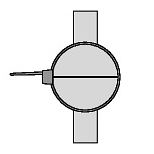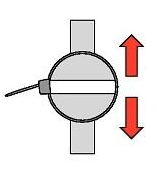Cable ties with plastic pawls

This technology is used in 90% of all polyamide (PA) cable ties. In order to cover a variety of applications, there are different variants of this system, for example: releasable versions, in-line versions, open head versions. These are one-piece cable ties that are the pawl moulded as an integral part of the cable tie, thereby building in inherent strengths. Positive locking is achieved by engaging the pawl with the strap serrations.
Cable ties KR series

This cable tie is distinguished by its smooth strap and unique locking mechanism. With the KR cable tie series the chamfered head achieves an especially firm fit around the bundled material.
MBT series of cable ties

Made of stainless steel grades 304 or 316, the MBT range of cable ties have no serrations on the strap and are threaded parallel through the head, gliding under a metal ball-bearing locking mechanism. The strap is locked into the head by means of the small ball-bearing.
Determination of minimum tensile strength of cable ties
The minimum tensile strength is a critical selection criteria for cable ties. It expresses how much loading a cable tie can bear. This minimum tensile strength of a cable tie is determined in accordance with the Military Specification and Standards of the USA. Test conditions being laid down precisely in MIL-S-23190E:
- Conditioning of the cable tie test pieces
- Construction of the test apparatus
- Application of the cable tie on a split test probe
- Test speed
The test procedure to determine minimum tensile strength of a cable tie

The cable tie is fixed onto a split mandrel test probe with the suitable cable tie application tool.

The mandrel is opened at a defined speed.

The loading at which the cable tie fails is determined.
Optimum storage conditions for cable ties made of polyamide (PA)
About 90% of cable ties and fixings are made from the thermoplastic synthetic material polyamide 66.
The polyamide PA66 has many properties which are highly advantageous, such as:
- High strength, rigidity and hardness
- High dimensional stability, even under the effect of heat
- High abrasion resistance
Having a wide range of polyamides and additives allows for an optimum adaptation of the properties of the finished cable tie or fixing element to suit the respective requirements.
Extremely resistent cable ties / fixing elements can be made from high-quality polyamide 66. This synthetic material will mainly be processed during injection moulding, but can also be extruded.
Polyamide is a hygroscopic material. This means that the cable tie material absorbs and loses moisture. For optimum handling of cable ties it is important that the cable tie material is in a condition of equilibrium with a water content of approximately 2.5%.
Therefore, it is important to store the products in their original packaging to preserve the quality of cable ties.

Always store cable ties in the sealed plastic bag made of polyethylene! Once opened you should use the cable ties as quickly as possible!

Do not expose cable ties to direct sunlight! Do not store cable ties in sunlight; for example, on the windowsill!

Store cable ties away from direct sources of heat! Avoid contact with heat: for example, do not place on the radiators!

The ideal storage conditions for cable ties are those of the central European standard climate:
For optimum handling of cable ties it is important that the material is in a condition of equilibrium with a water content of approximately 2.5%.

